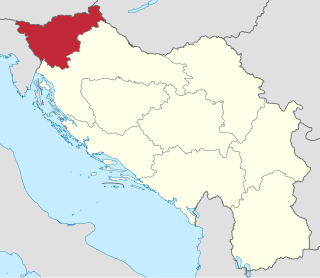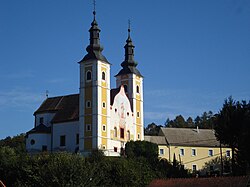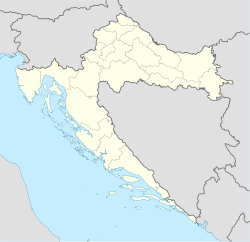
Međimurje County is a triangle-shaped county in the northernmost part of Croatia, roughly corresponding to the historical and geographical region of Međimurje. It is the smallest Croatian county by size, as well as the most densely populated. The county's seat and main urban centre is Čakovec.

Čakovec is a city in Northern Croatia, located around 90 kilometres north of Zagreb, the Croatian capital. Čakovec is both the county seat and the largest city of Međimurje County, the northernmost, smallest and most densely populated Croatian county.

Mursko Središće is the northernmost town in Croatia, located at 46.509°N 16.441°E and one of the oldest localities in Međimurje County.

Nedelišće is a village in Međimurje County, in northern Croatia, and the seat of the Municipality of Nedelišće, which also includes 10 other villages in the south-western part of Međimurje County.

The Drava Banovina or Drava Banate, was a province (banovina) of the Kingdom of Yugoslavia between 1929 and 1941. This province consisted of most of present-day Slovenia and was named for the Drava River. The capital city of the Drava Banovina was Ljubljana.

Gornji Mihaljevec is a village and municipality in Međimurje County, in northern Croatia.

Selnica is a village and municipality in Međimurje County, in northern Croatia.

Sveti Juraj na Bregu is a municipality in Međimurje County, Croatia.

Sveti Martin na Muri is a village and municipality in Međimurje County, in northern Croatia.
Črečan is a village in northern Croatia, part of the Nedelišće municipality within Međimurje County.
Trnovec is a village in northern Croatia, part of the Nedelišće municipality within Međimurje County.

Međimurje is a small historical and geographical region in Northern Croatia comprising the area between the two large rivers, Mura and Drava, and roughly corresponding to the administrative division of Međimurje County.

Banfi is a village in northern Croatia, part of the Štrigova municipality within Međimurje County. The village is located at the border with Slovenia.

Robadje is a village in northern Croatia, part of the Štrigova municipality within Međimurje County. The village is located at the border with Slovenia.

Leskovec is a village in northern Croatia, part of the Štrigova municipality within Međimurje County. Village is located near the border with Slovenia.

Železna Gora is a village in northern Croatia, part of the Štrigova municipality within Međimurje County.

Lapšina is a village in northern Croatia, part of the Sveti Martin na Muri municipality within Međimurje County.

Žabnik is the northernmost settlement in Croatia, located in the Sveti Martin na Muri municipality of Međimurje County.

Grabrovnik is a village in northern Croatia, part of the Štrigova municipality within Međimurje County.

Međimurje under Hungarian rule is the historical period of Međimurje, the northernmost part of Croatia, from the Early modern period to Late modern period, during which it was an integral part of Zala County in Hungary. It was a centuries-old aspiration of the Hungarian rulers that came true in 1720, as Međimurje was acquired by Michael Johann III. Althann (1679–1727), a Habsburg Count and member of the House of Althann, an ancient German noble family. Until then, although in the possession of Croatian, Hungarian and Austrian noblemen, Međimurje was mostly part of the Varaždin County, which formally belonged to the medieval Kingdom of Slavonia or early modern Kingdom of Slavonia, one of Croatian lands. From 1527 the entire territory fell under Habsburg Monarchy and after the formation of Croatian Military Frontier on parts of the Croatian territory, Međimurje remained outside it and was, as before, under the administration of the Ban (Banus) of Croatia.
































